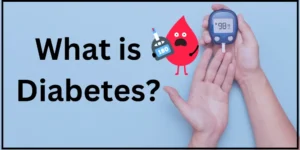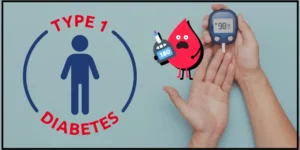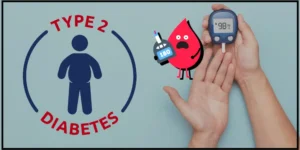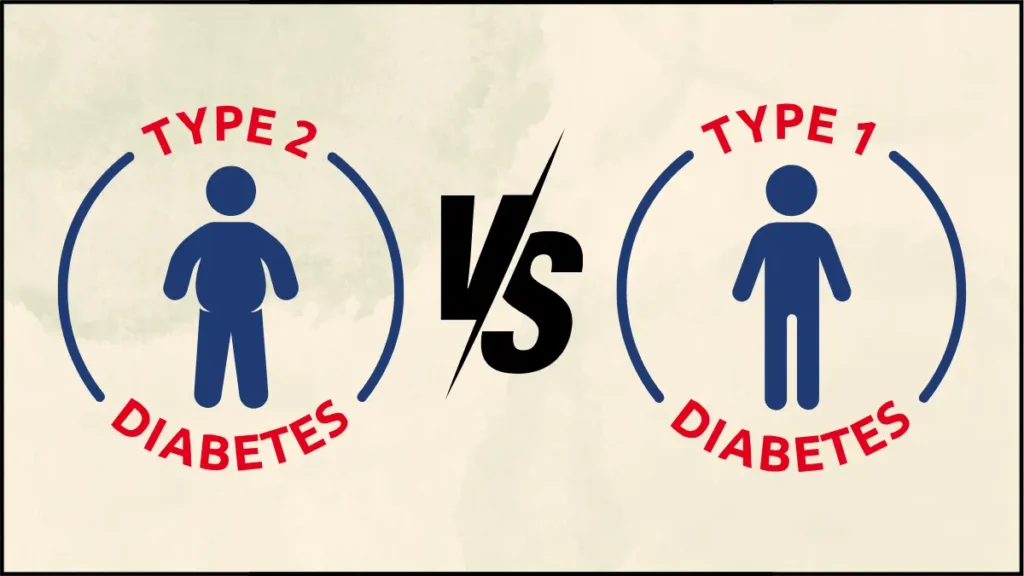If you’ve ever wondered about type 2 vs type 1 diabetes, you’re not alone.
Diabetes is one of the most common chronic conditions worldwide, affecting millions of people across all age groups. But not all diabetes is the same. You may have often heard of the type 2 vs type 1 diabetes debate, but do you know what sets them apart?
Many people assume they are just different stages of the same disease, and it’s completely understandable! But that’s not the case.
Both conditions affect how the body handles blood sugar. But, type 2 vs type 1 diabetes which one affects more: How the body processes blood sugar (glucose), and what are the different causes, risk factors, and treatment approaches.
Understanding the differences is essential, not only for those diagnosed but also for caregivers, family members, and anyone looking to prevent diabetes-related complications.
This article will break it down in a simple, interactive way. Whether you’re newly diagnosed, supporting a loved one, or just curious, this guide will help you understand the key differences between type 2 vs type 1 diabetes and why they matter.
Here we will explore the following:
Table of Contents
Let’s get started!
What is Diabetes Anyway?
Diabetes is a long-term condition that affects how your body regulates blood sugar (also called glucose). Glucose is the primary source of energy for your body’s cells, and it comes from the food you eat.

However, for your cells to absorb glucose and use it for energy, they need insulin, a hormone made by the pancreas.
Think of insulin like a key and your cells like doors. When insulin is present, it unlocks the doors, allowing glucose to enter and be used for energy. But with diabetes, something goes wrong with this process.
Either the body doesn’t produce insulin at all (type 1 diabetes) or the cells stop responding properly to insulin (type 2 diabetes). As a result, glucose builds up in the bloodstream, leading to high blood sugar levels.
Now, let’s dive into type 2 vs type 1 diabetes and see what makes them different!
Before you go with this Type 2 vs Type 1 Diabetes Article. I have a question for you: Are you looking for Supplements to regulate your blood sugar levels, then check out the Shop by Smart Sugar Control
Type 1 Diabetes: The Autoimmune Attack
When talking about Type 2 vs Type 1 Diabetes, type 1 diabetes is completely different. Let me explain how: Imagine your body’s immune system as a security guard that’s supposed to protect you from invaders like viruses and bacteria.
In type 1 diabetes, this security guard gets confused and mistakenly attacks the insulin-producing beta cells in your pancreas. Over time, this leads to little or no insulin production.
Without insulin, glucose builds up in the bloodstream instead of entering the cells, causing dangerously high blood sugar levels.

Why Does This Happen?
Doctors aren’t entirely sure what triggers this immune system attack, but research suggests that a combination of genetics and environmental factors like viral infections may play a role.
Unlike type 2 diabetes, type 1 is not caused by diet or lifestyle choices.
Key Facts About Type 1 Diabetes:
- It’s an autoimmune disease, meaning the immune system attacks healthy cells by mistake.
- It usually starts in childhood or early adulthood, but anyone can get it.
- People with type 1 diabetes must take insulin every day because their bodies don’t produce any.
- It’s not caused by poor diet or lack of exercise it happens because of genetics and unknown triggers.
- There is no cure, but it can be managed effectively with insulin therapy and blood sugar monitoring.
Symptoms of Type 1 Diabetes:
- Extreme thirst and frequent urination – High blood sugar levels make the kidneys work overtime to filter out excess glucose, leading to dehydration and more bathroom trips.
- Sudden weight loss – Since the body isn’t getting energy from glucose, it starts burning fat and muscle instead.
- Constant hunger, even after eating – Without insulin, cells can’t absorb glucose, leaving the body in a state of energy starvation.
- Blurry vision – High blood sugar levels can cause fluid to shift in the eyes, affecting vision.
- Feeling very tired – Without proper glucose absorption, energy levels drop.
- Irritability or mood changes – Fluctuating blood sugar levels can affect brain function and mood.
Managing Type 1 Diabetes
People with type 1 diabetes must take insulin through injections or an insulin pump to regulate their blood sugar levels. They also need to:
- Monitor blood sugar levels regularly using a glucose meter or continuous glucose monitor (CGM).
- Follow a healthy, balanced diet to help control blood sugar spikes and dips.
- Exercise regularly, while carefully managing insulin levels to prevent low blood sugar (hypoglycemia).
- Work closely with healthcare professionals to adjust insulin doses as needed.
Although managing type 1 diabetes requires constant attention, advancements in diabetes technology like insulin pumps and CGMs, are making it easier to live a healthy, active life.
Type 2 Diabetes: The Resistance Problem
In the context of Type 2 vs Type 1 Diabetes, Type 2 diabetes works completely different from Type 1 diabetes. In this case, the body still makes insulin, but the cells stop responding to it properly.
Think of it like a locked door the key (insulin) is there, but the lock (cells) is rusty and won’t open. This is called insulin resistance. Over time, the pancreas gets overworked trying to make more insulin, and eventually, it can’t keep up.
This leads to rising blood sugar levels, which can cause serious health problems if left unmanaged.

Why Does This Happen?
Several factors contribute to insulin resistance and the development of type 2 diabetes:
- Obesity – Excess fat, especially around the abdomen, makes it harder for cells to respond to insulin.
- Lack of physical activity – Regular movement helps cells become more sensitive to insulin.
- Unhealthy diet – Consuming too much sugar and processed foods can strain the pancreas over time.
- Genetics – If type 2 diabetes runs in your family, your risk is higher.
- Aging – As people get older, their insulin sensitivity naturally declines.
Key Facts About Type 2 Diabetes:
- It’s much more common than type 1 diabetes—about 90-95% of diabetes cases are type 2.
- It usually develops in adults, but due to unhealthy diets and sedentary lifestyles, more young people are being diagnosed.
- Obesity, poor diet, and lack of exercise are major risk factors.
- Some people can manage it with diet and exercise, but others may need medication or insulin.
Symptoms of Type 2 Diabetes:
The symptoms of type 2 diabetes can develop slowly, making it harder to detect early. Common signs include:
- Increased thirst and frequent urination – Similar to type 1, high blood sugar causes excessive urination and dehydration.
- Feeling tired or sluggish – When cells don’t get enough energy, you feel fatigued.
- Slow-healing cuts or infections – High blood sugar weakens the immune system and slows healing.
- Tingling or numbness in the hands and feet – Nerve damage (neuropathy) can develop over time.
- Dark patches of skin – A condition called acanthosis nigricans, which can indicate insulin resistance.
Managing Type 2 Diabetes
The good news? In the debate of Type 2 vs Type 1 Diabetes only Type 2 diabetes can often be prevented or even reversed with lifestyle changes. The goal is to improve insulin sensitivity and keep blood sugar levels in check. Here’s how:
- Healthy Eating – Focus on whole foods, fiber-rich vegetables, lean proteins, and healthy fats. Cut back on processed carbs and sugary drinks.
- Regular Exercise – Physical activity helps cells respond better to insulin. Aim for at least 30 minutes of movement per day.
- Weight Management – Losing even 5-10% of body weight can dramatically improve blood sugar control.
- Medication or Insulin Therapy – Some people may need oral medications like Metformin or, in more advanced cases, insulin therapy.
- Blood Sugar Monitoring – Keeping track of glucose levels can help adjust lifestyle and treatment plans as needed.
Type 2 diabetes does not have to be a life sentence. With the right approach, many people can manage or even reverse the condition and live a full, healthy life!
The good news? Type 2 diabetes can often be prevented or even reversed with lifestyle changes like eating a healthy diet, exercising, and maintaining a healthy weight.
Before you go with this Type 2 vs Type 1 Diabetes Article. I have a question for you: Are you looking for Supplements to regulate your blood sugar levels, then check out the Shop by Smart Sugar Control
Comparing Type 2 vs Type 1 Diabetes
While both types of diabetes affect how the body handles blood sugar, they have major differences in terms of cause, onset, management, and treatment. Here’s a detailed comparison:
1. Cause
- Type 1 diabetes: Autoimmune reaction that destroys insulin-producing cells in the pancreas.
- Type 2 diabetes: The body becomes resistant to insulin, often due to genetics, lifestyle, and obesity.
2. Onset Age
- Type 1 diabetes: Usually diagnosed in children, teens, or young adults.
- Type 2 diabetes: More common in adults but increasing in younger populations due to lifestyle changes.
3. Insulin Production
- Type 1 diabetes: The body produces little to no insulin.
- Type 2 diabetes: The body produces insulin but doesn’t use it properly.
4. Treatment Approach
- Type 1 diabetes: Requires insulin therapy for survival.
- Type 2 diabetes: Can often be managed with diet, exercise, and medications.
5. Risk Factors
- Type 1 diabetes: Genetic predisposition and unknown environmental triggers.
- Type 2 diabetes: Family history, poor diet, lack of exercise, and obesity increase the risk.
6. Prevention
- Type 1 diabetes: Cannot be prevented.
- Type 2 diabetes: Can often be prevented or delayed with lifestyle changes.
7. Lifestyle Adjustments
- Type 1 diabetes: Requires careful meal planning and insulin management.
- Type 2 diabetes: Focuses on diet, exercise, and weight control.
8. Family History & Risk Factors
- Type 1 diabetes: Having a family member with type 1 diabetes increases your risk, but it is not directly caused by lifestyle factors.
- Type 2 diabetes: A family history of type 2 diabetes, obesity, an unhealthy diet, and lack of physical activity all increase the risk.
9. Medication Differences
- Type 1 diabetes: Insulin is required for survival.
- Type 2 diabetes: Medications such as metformin and SGLT2 inhibitors may be prescribed to help control blood sugar, along with lifestyle changes.
10. Lifestyle Adjustments
- Type 1 diabetes: Requires careful meal planning, insulin timing, and blood sugar monitoring to prevent extreme highs and lows.
- Type 2 diabetes: Diet and exercise play a key role in reversing or managing the condition.
11. Impact on Daily Life
- Type 1 diabetes: More unpredictable due to insulin dependence; requires constant monitoring.
- Type 2 diabetes: Can often be managed with lifestyle changes alone in early stages.
12. Long-Term Complications
Both types of diabetes can lead to complications like nerve damage, heart disease, kidney failure, and vision problems if not well-managed.
Comparison Table: Type 2 vs Type 1 Diabetes
| Features | Type 1 Diabetes | Type 2 Diabetes |
| Cause | Autoimmune reaction destroys insulin-producing cells | Insulin resistance due to lifestyle and genetic factors |
| Onset Age | Usually diagnosed in children or young adults | More common in adults but increasing in younger people |
| Insulin Production | Little to no insulin is produced | The body produces insulin but doesn’t use it properly |
| Treatment | Requires insulin therapy for survival | Can often be managed with diet, exercise, and medications |
| Risk Factors | Genetic predisposition, unknown triggers | Family history, poor diet, lack of exercise, obesity |
| Prevention | Cannot be prevented | Can often be prevented or delayed with lifestyle changes |
| Lifestyle Adjustments | Requires careful meal planning and insulin management | Focuses on diet, exercise, and weight control |
| Long-Term Complications | Both types can lead to complications like nerve damage, heart disease, kidney failure, and vision problems if not well-managed |
Why understanding Type 2 vs Type 1 Diabetes Matters?
Understanding the differences type 2 vs type 1 diabetes is crucial because it affects how the condition is managed. Misinformation can be dangerous, and knowing which type of diabetes you or a loved one has leads to better treatment decisions.
- For people with type 1 diabetes, knowing they need lifelong insulin therapy helps them avoid serious complications like diabetic ketoacidosis (DKA), which can be life-threatening.
- For those with type 2 diabetes, understanding that lifestyle changes can often prevent or reverse the condition empowers them to take action before complications arise.
- For caregivers and family members, knowing the difference ensures they provide the right support—whether that means recognizing low blood sugar emergencies in type 1 diabetes or helping a loved one adopt healthier habits to manage type 2.
- For society as a whole, better awareness leads to better policies, research funding, and healthcare improvements that benefit everyone affected by diabetes.
By learning about type 2 vs type 1 diabetes, you can make informed choices, support loved ones, and advocate for better diabetes care. Knowledge truly is power!
Before you go with this Type 2 vs Type 1 Diabetes Article. I have a question for you: Are you looking for Supplements to regulate your blood sugar levels, then check out the Shop by Smart Sugar Control
Conclusion
While the debate of type 2 vs type 1 diabetes has been going on for long now. Both type 1 and type 2 diabetes are different in their causes and management, both require careful attention to maintain a healthy life. Awareness, early diagnosis, and proper treatment are key to preventing complications and improving quality of life.
Understanding these differences empowers individuals to make the right choices for their health, whether it’s managing insulin levels, making lifestyle changes, or seeking medical support. If you or someone you love has diabetes, staying informed and proactive is the best way to lead a fulfilling and healthy life.
By taking control of your diabetes whether through insulin therapy, dietary adjustments, exercise, or medical interventions you can minimize the risk of complications like nerve damage, kidney disease, heart problems, and vision loss. The key is to stay consistent and proactive in your approach to diabetes management.
It’s also important to remember that no one is alone in this journey. There are countless resources, support groups, and healthcare professionals who can provide guidance and encouragement.
If you’re newly diagnosed, don’t be afraid to reach out for support, ask questions, and learn as much as you can about managing your condition effectively also read this type 2 vs type 1 diabetes article once again to make an informed decision.
Diabetes doesn’t have to define your knowledge, the right habits, and medical guidance can help you take control of your health and well-being. Stay informed, stay proactive, and empower yourself to live your healthiest life.
Did this article on type 2 vs type 1 diabetes help you understand the difference? Let us know in the comments or share it with someone who might find it useful!
References
The above article Type 2 vs Type 1 Diabetes has been written with reference to the information from the following website:
- American Diabetes Association (ADA) – https://www.diabetes.org
- Centers for Disease Control and Prevention (CDC) – Diabetes – https://www.cdc.gov/diabetes
- National Institute of Diabetes and Digestive and Kidney Diseases (NIDDK) – https://www.niddk.nih.gov
- Mayo Clinic – Diabetes Overview – https://www.mayoclinic.org/diseases-conditions/diabetes
- World Health Organization (WHO) – Diabetes – https://www.who.int/health-topics/diabetes
These sources provide up-to-date, research-backed information about type 2 vs type 1 diabetes, their causes, symptoms, and management.
If you liked this article on Type 2 vs Type 1 Diabetes then check more articles by us in the Blog by Smart Sugar Control.
Type 2 vs Type 1 Diabetes
